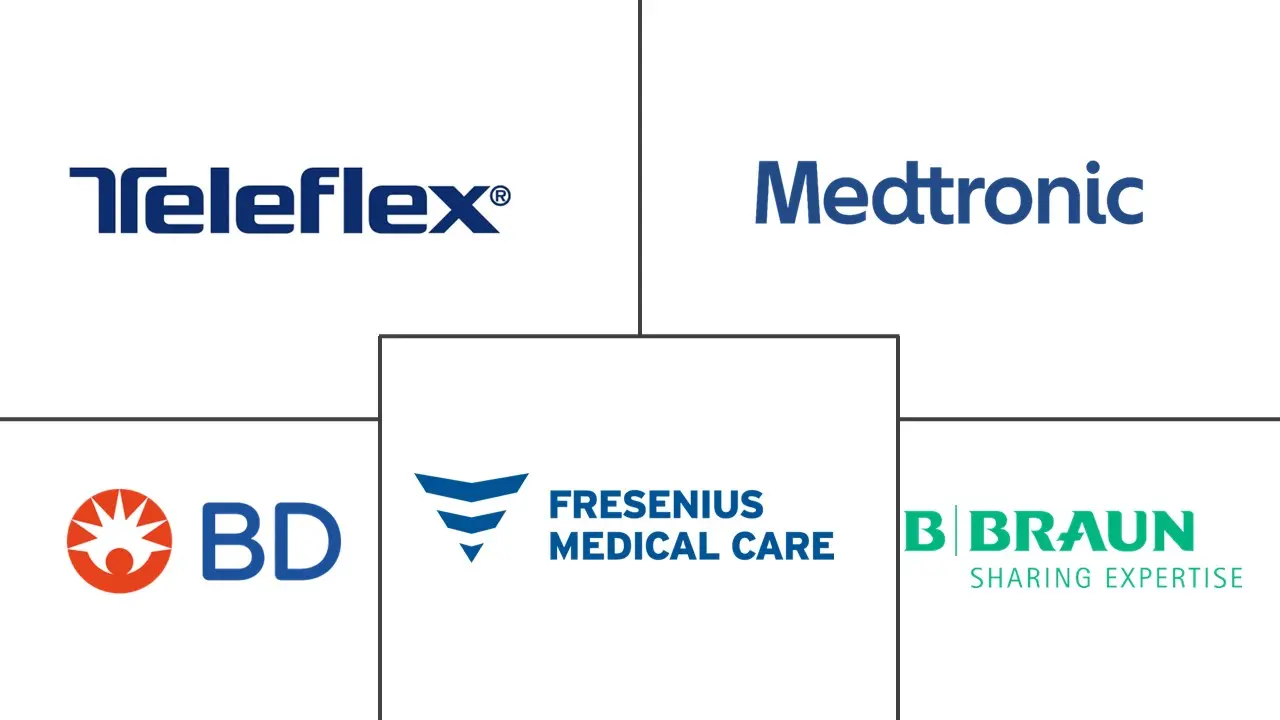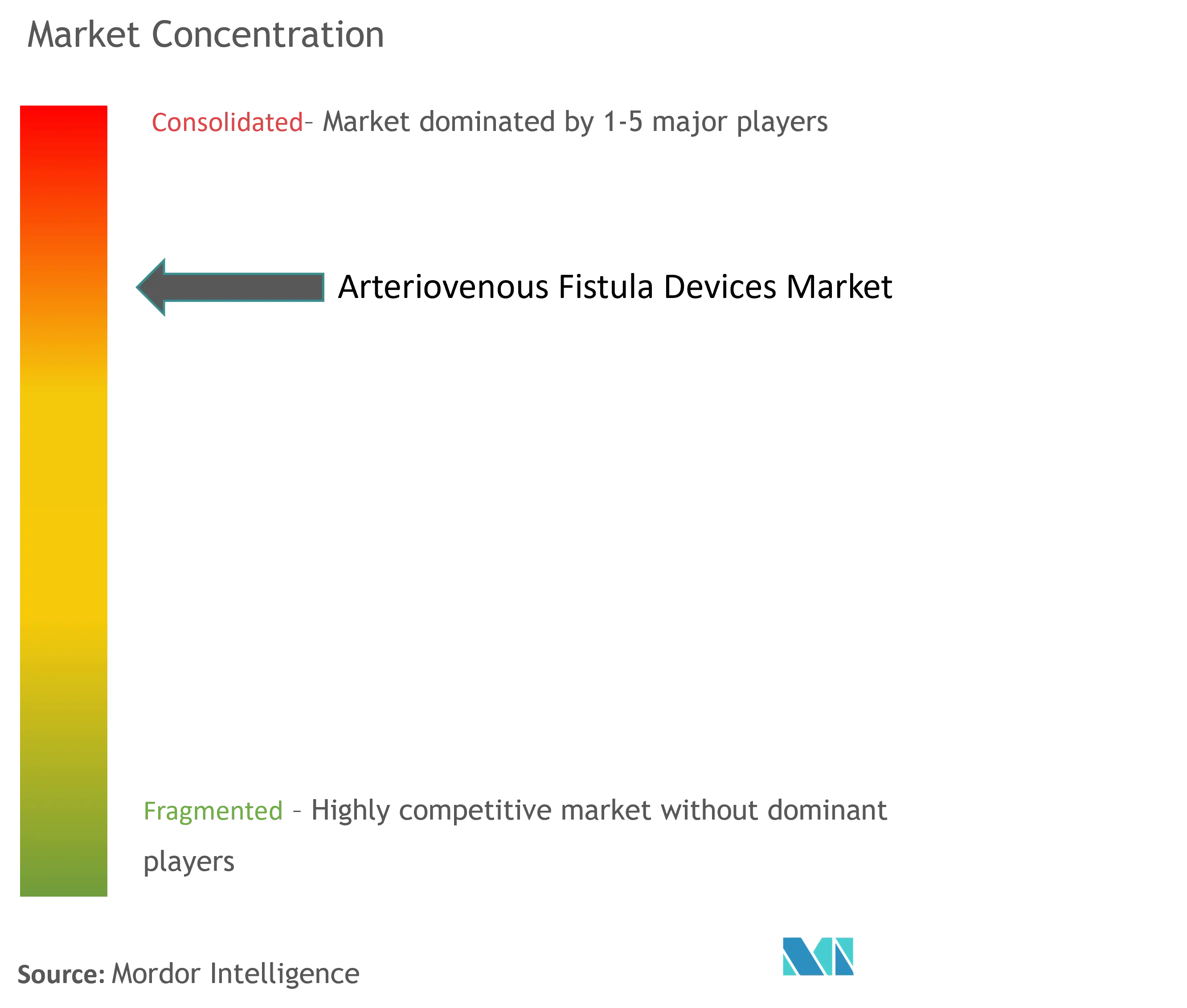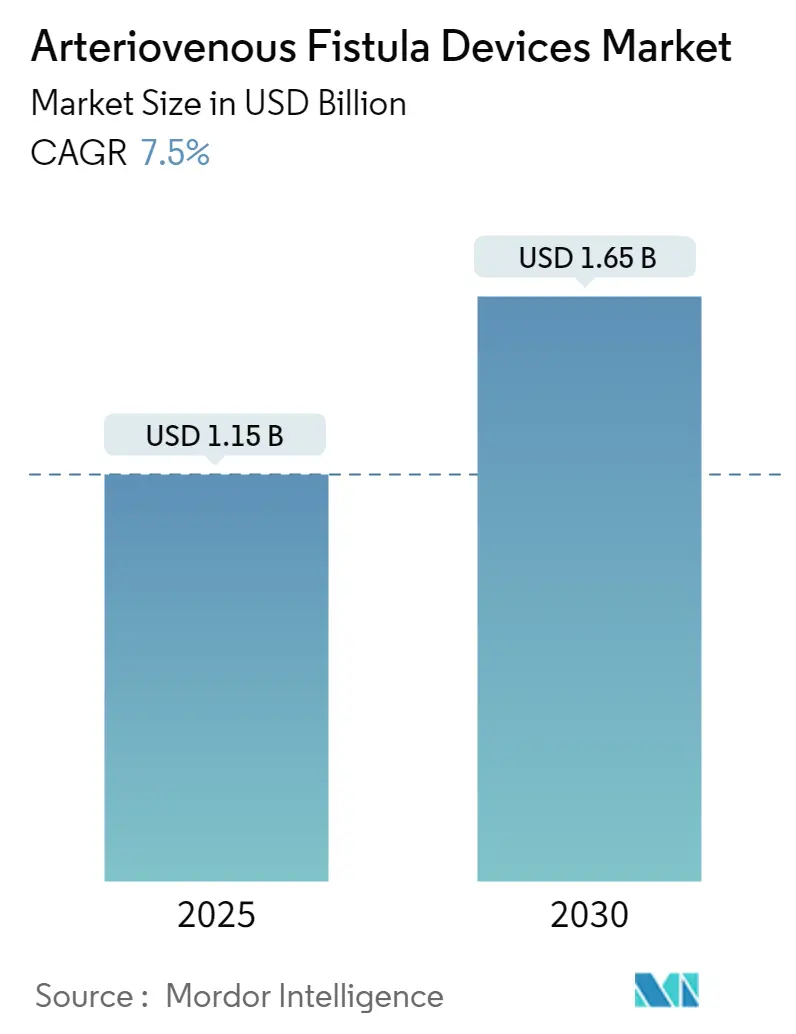
Arteriovenous Fistula Devices Market Analysis
The Arteriovenous Fistula Devices Market size is estimated at USD 1.15 billion in 2025, and is expected to reach USD 1.65 billion by 2030, at a CAGR of 7.5% during the forecast period (2025-2030).
Several factors drive the market for arteriovenous fistula (AVF) devices. A primary factor is the increasing prevalence of end-stage renal disease (ESRD), which often requires hemodialysis. AVFs are essential for ensuring reliable vascular access during these dialysis treatments. Furthermore, the growing adoption of minimally invasive procedures, including endovascular techniques and embolization, has further boosted the demand for AVF devices.
The rising incidence of ESRD, often associated with conditions like diabetes and hypertension, necessitates more efficient and effective dialysis access solutions. As more patients require dialysis, the demand for AV fistulas, which provide a reliable and long-term access point for hemodialysis, is increasing, driving the market's growth. For instance, as per Kidney Care Report 2023, in the United Kingdom, roughly 30,000 individuals depend on dialysis for survival, and annually, about 3,000 undergo kidney transplants. An estimated 3.25 million adults, accounting for over 10% of the adult population, live with chronic kidney disease (CKD) stages 3-5. Projections for 2033 indicate a rise in dialysis-dependent adults to around 33,845 and an increase in annual kidney transplants to about 3,615. Thus, the high burden of ESRD is expected to increase the demand for AVF to provide a reliable and long-term access point for hemodialysis, driving the market's growth.
In addition, as per the above context, by 2030, the incidence of ESRD is projected to double, influenced by factors like diabetes, hypertension, and an aging population in the United Kingdom. Additionally, the share of patients in the later stages of CKD is anticipated to rise from 45% to 51% in the coming decade. The increasing burden of end-stage renal disease (ESRD) is expected to drive the market for arteriovenous (AV) fistula devices, thereby boosting market growth.
Key players in the AVF device market are actively pursuing strategic initiatives to bolster the market's growth. For instance, in January 2023, Alucent Biomedical Inc. is committed to advancing its AlucentNVS technology, which is aimed at treating vascular diseases. The company initiated its ACTIVATE AVF study to assess the safety and feasibility of the AlucentNVS therapy for arteriovenous fistula (AVF) in patients with end-stage renal disease (ESRD).
The AlucentNVS therapy is designed to accelerate and improve the physiological and functional maturation of AVF devices. If successful, this therapy could provide more patients with timely and reliable access to essential dialysis treatments. Technological advancements enhance patient outcomes and reduce complications associated with AVF procedures, driving the demand for innovative AVF devices and fostering a positive market trend.
The growing burden of ESRD is significantly impacting the market for AV fistula devices. As the prevalence of kidney disease rises, combined with a clear preference for the benefits of AV fistulas, technological advancements, and supportive healthcare policies, the demand for these devices is expected to increase. However, surgical complications and risks are expected to hamper the market's growth.
Arteriovenous Fistula Devices Market Trends
The Vascular Grafts Segment is Expected to Hold a Significant Share During the Forecast Period
Vascular grafts play a crucial role in the creation of arteriovenous fistulas (AVFs), particularly when direct access to suitable native veins is not feasible. Vascular grafts are designed to enhance blood flow and maintain patency, which is essential for the long-term success of dialysis access. Improved graft materials and designs help reduce the risk of thrombosis and other complications. The growth of the vascular graft segment in the AVF market is driven by the increasing burden of kidney disease, the preference for AVFs, advancements in graft technology, rising awareness, and supportive healthcare policies.
The increasing research and development of vascular grafts that facilitate the AVF is expected to increase demand for these grafts, which is expected to drive the market's growth. For instance, in October 2022, Porto Vascular Congress (PVC), organized by the European Society of Vascular Surgery (ESVS), Xeltis unveiled promising preliminary efficacy and safety results from one of the centers involved in the AXESS first-in-human (FIH) clinical trial. This trial focuses on restorative hemodialysis vascular access graft, the aXess. Thus, such launches of vascular grafts are expected to increase its adoption, in turn driving the segment's growth.
The increasing key initiatives in research on vascular grafts that help in AVF procedures are anticipated to boost the segment's growth. For instance, American Society of Nephrology (ASN) Kidney Week 2023 discussed a range of topics related to arteriovenous fistulas (AVFs), presented on various grafts, and introduced devices designed to alleviate vein obstructions catering specifically to the needs of dialysis patients. The STARgraft AV Graft features a synthetic expanded polytetrafluoroethylene (ePTFE) core, which is coated externally with soft, porous silicone granules. This innovative design employs a unique pore geometry that promotes capillary ingrowth while preventing fibrotic encapsulation. Additionally, the graft resists infections and adapts to the pulsating nature of blood while maintaining wall compliance. These benefits were validated through clinical tests, comparing 73 STAR grafts to 27 control grafts. Thus, the availability of such products in the market is expected to increase its demand, contributing to the segment's growth.
Moreover, strategic activities by the market players, such as product launches and collaboration, are anticipated to propel the segment's growth during the forecast period. For instance, in March 2024, Peca Labs obtained another CE Mark for its exGraft line of vascular grafts in European countries. Developed through Peca Labs' proprietary polymer processing platform, the synthetic exGraft vascular graft allows for permanent expansion. Consequently, these launches and regulatory approvals are anticipated to boost demand, fueling the market's growth.
Thus, the aforementioned factors, such as growing research and development activities and launches, are anticipated to boost the segment's growth during the forecast period.
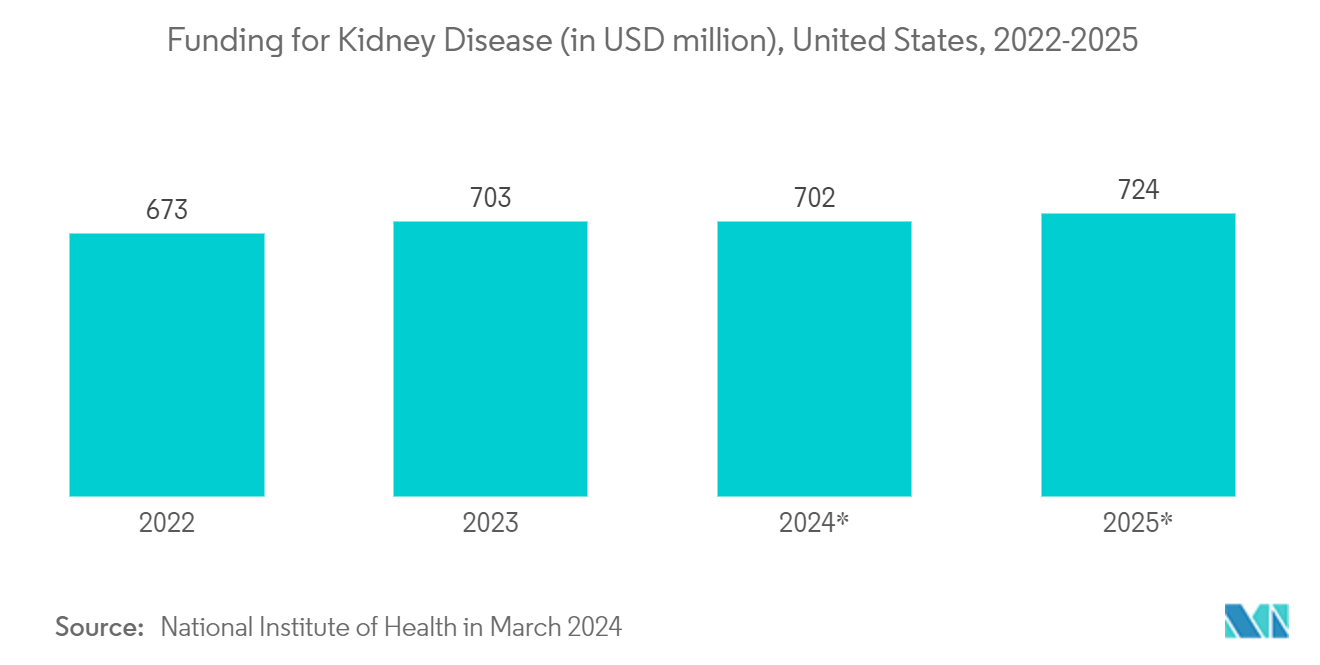
North America is Expected to Hold a Significant Share in the Market During the Forecast Period
The North American AVF market is growing owing to factors such as the burden of ESRD, the increasing prevalence of chronic conditions such as diabetes and hypertension, and growing awareness and education among healthcare providers and patients regarding early detection and management of kidney disease. Additionally, government initiatives and support programs aimed at improving kidney care and increasing funding for treatment options further bolster the market's growth.
Diabetes and hypertension are the leading causes of ESRD. As the prevalence of these chronic conditions rises, more patients require renal replacement therapies, including hemodialysis. This increases the demand for reliable vascular access solutions like AVFs, contributing to the market's growth. For instance, as per Diabetes Canada 2024, in Canada, nearly 5.9 million individuals, or roughly 15% of the population, are affected by diabetes, encompassing both diagnosed and undiagnosed cases. Of these, about 4.1 million have been formally diagnosed with either type 1 or type 2 diabetes. Projections indicate that by 2033, the diabetic population in Canada could increase to around 7.4 million, making up about 17% of the total populace. Over the next ten years, diagnosed cases of diabetes are anticipated to surge by approximately 26%. Thus, the high burden of diabetes creates a cascading effect on the AVF market, as the resulting increase in ESKD cases drives the demand for effective and reliable dialysis access solutions.
Moreover, increasing awareness about key diseases and their diagnosis is anticipated to bolster the demand for their treatment and is likely to spur the market for AVF during the forecast period. For instance, National Kidney Month is observed in March, with various organizations, notably the National Kidney Foundation (NKF), spearheading initiatives to raise awareness about kidney health. These campaigns highlight the critical role of early detection, advocating for straightforward blood and urine tests to catch chronic kidney disease (CKD) before it advances to end-stage renal disease (ESRD).
Additionally, in June 2024, the AAKP unveiled its "Every Patient Safe" campaign, spotlighting the distinct challenges kidney patients encounter. This campaign seeks to inform the susceptibilities of kidney patients, underscoring the urgency of early detection and proactive steps to combat kidney disease.
Furthermore, strategic moves by market players, including product launches and collaborations, are expected to drive the segment's growth during the forecast period. For instance, in July 2024, VentureMed Group Inc. focuses on access management for arteriovenous (AV) fistulas (AVFs) and grafts (AVGs) and prepares vessels for treating peripheral arterial disease. The company has completed enrollment for the FLEX First AV registry. This registry aims to show that using the VentureMed Flex vessel prep (VP) system, in conjunction with balloon angioplasty, enhances the primary patency rate of target lesions in patients with AVF/AVG stenosis. This is being compared to published rates for balloon angioplasty used in isolation.
Thus, increasing the burden of chronic diseases such as diabetes and hypertension, increasing awareness initiatives for diagnosis and treatment, and product launches by the market players are expected to boost the market's growth during the forecast period.
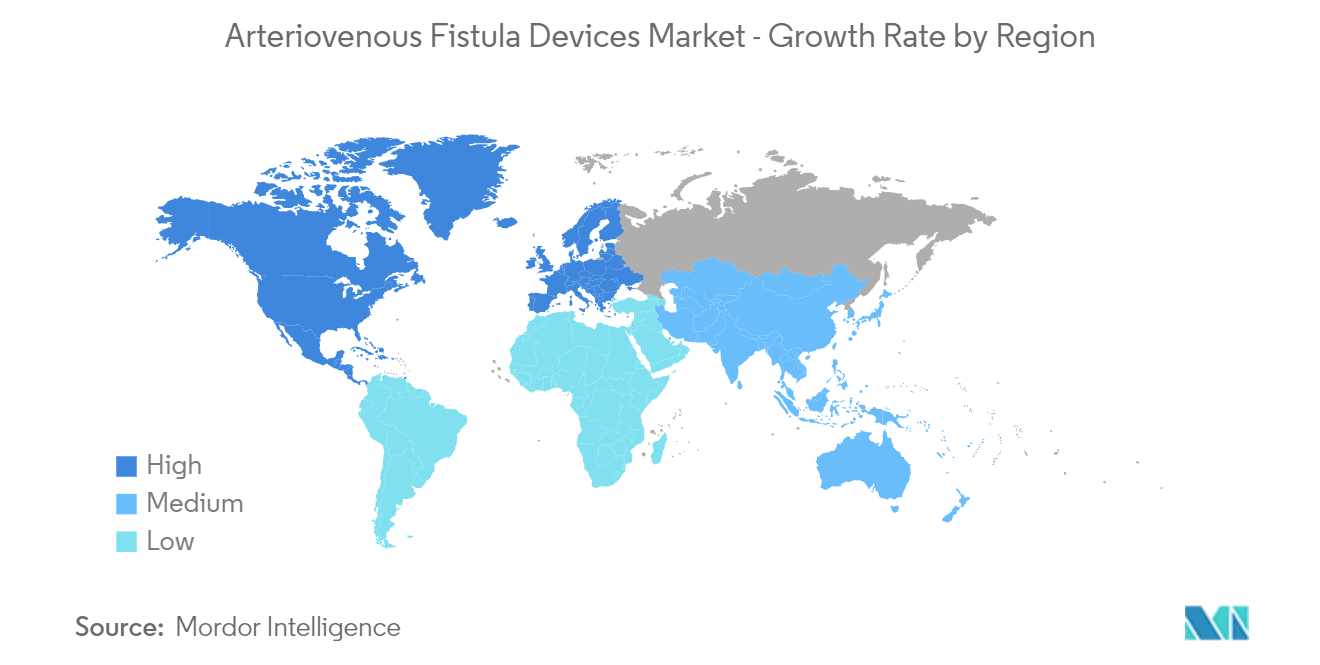
Arteriovenous Fistula Devices Industry Overview
The arteriovenous fistula devices market is consolidated with the presence of few players. Key players are strategically pursuing acquisitions, mergers, collaborations, and vigorous research and development efforts to bolster their market dominance. These endeavors focus on fortifying product portfolios, broadening market reach, and spearheading innovations in AVF device technologies. Key players in the market include Medtronic, BD, Teleflex Incorporated, Fresenius Medical Care AG & Co. KGaA, B. Braun SE, Polymedicure, NxStage Medical Inc., and Laminate Medical Technologies.
Arteriovenous Fistula Devices Market Leaders
-
Medtronic
-
BD
-
Teleflex Incorporated
-
B. Braun SE
-
Fresenius Medical Care AG & Co. KGaA.
- *Disclaimer: Major Players sorted in no particular order
Arteriovenous Fistula Devices Market News
- September 2024: XS Innovations, a spinout from Leiden University Medical Center (LUMC) and Delft University of Technology (TU Delft), closed a seed funding round, raising EUR 1.1 million (USD 1.22 million). These funds will expedite the development of XS Innovations’ Dynamic AVF, a vascular access device aimed at mitigating common complications linked to hemodialysis.
- January 2024: Laminate Medical successfully implanted its VasQ device for the first time in the United States, with the procedure conducted by Ari Kramer at Spartanburg Regional Hospital in Spartanburg, United States. The VasQ technology received approval from the United States Food and Drug Administration (FDA) in September 2023. Notably, it stands as the sole product of its kind currently approved on the market, specifically engineered to enhance the success of surgical fistulas right from their inception.
Arteriovenous Fistula Devices Industry Segmentation
As per the scope of the report, arteriovenous (AV) fistula devices are medical tools used to create a connection between an artery and a vein, typically for the purpose of providing long-term access to hemodialysis in patients with kidney failure. The procedure involves surgically joining an artery to a vein, which allows for increased blood flow to the vein, leading to its dilation and maturation over time.
The arteriovenous (AV) fistula devices market is segmented by type, end user, and geography. By type, the market is segmented into AVF creation devices, AVF monitoring devices, and AVF maintenance devices. By end user, the market is segmented into hospitals, ambulatory surgical centers, and dialysis centers. By geography, the market is segmented into North America, Europe, Asia-Pacific, Middle East and Africa, and South America. The report offers the value (USD) for the above segments.
| By Type | AVF Creation Devices | Surgical Instruments | |
| Vascular Grafts | |||
| Angioplasty Balloons | |||
| Others | |||
| AVF Monitoring Devices | Doppler Ultrasound | ||
| Pressure Monitoring Systems | |||
| Others | |||
| AVF Maintenance Devices | Central Venous Catheters | ||
| Stents | |||
| Others | |||
| End User | Hospitals | ||
| Ambulatory Surgical Centers | |||
| Dialysis Centers | |||
| Geography | North America | United States | |
| Canada | |||
| Mexico | |||
| Europe | Germany | ||
| United Kingdom | |||
| France | |||
| Italy | |||
| Spain | |||
| Rest of Europe | |||
| Asia-Pacific | China | ||
| Japan | |||
| India | |||
| Australia | |||
| South Korea | |||
| Rest of Asia-Pacific | |||
| Middle East and Africa | GCC | ||
| South Africa | |||
| Rest of Middle East and Africa | |||
| South America | Brazil | ||
| Argentina | |||
| Rest of South America | |||
Arteriovenous Fistula Devices Market Research FAQs
How big is the Arteriovenous Fistula Devices Market?
The Arteriovenous Fistula Devices Market size is expected to reach USD 1.15 billion in 2025 and grow at a CAGR of 7.5% to reach USD 1.65 billion by 2030.
What is the current Arteriovenous Fistula Devices Market size?
In 2025, the Arteriovenous Fistula Devices Market size is expected to reach USD 1.15 billion.
Who are the key players in Arteriovenous Fistula Devices Market?
Medtronic, BD, Teleflex Incorporated, B. Braun SE and Fresenius Medical Care AG & Co. KGaA. are the major companies operating in the Arteriovenous Fistula Devices Market.
Which is the fastest growing region in Arteriovenous Fistula Devices Market?
Asia Pacific is estimated to grow at the highest CAGR over the forecast period (2025-2030).
Which region has the biggest share in Arteriovenous Fistula Devices Market?
In 2025, the North America accounts for the largest market share in Arteriovenous Fistula Devices Market.
What years does this Arteriovenous Fistula Devices Market cover, and what was the market size in 2024?
In 2024, the Arteriovenous Fistula Devices Market size was estimated at USD 1.06 billion. The report covers the Arteriovenous Fistula Devices Market historical market size for years: 2019, 2020, 2021, 2022, 2023 and 2024. The report also forecasts the Arteriovenous Fistula Devices Market size for years: 2025, 2026, 2027, 2028, 2029 and 2030.
Arteriovenous Fistula Devices Industry Report
Statistics for the 2025 Arteriovenous Fistula Devices market share, size and revenue growth rate, created by Mordor Intelligence™ Industry Reports. Arteriovenous Fistula Devices analysis includes a market forecast outlook for 2025 to 2030 and historical overview. Get a sample of this industry analysis as a free report PDF download.

